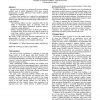Free Online Productivity Tools
i2Speak
i2Symbol
i2OCR
iTex2Img
iWeb2Print
iWeb2Shot
i2Type
iPdf2Split
iPdf2Merge
i2Bopomofo
i2Arabic
i2Style
i2Image
i2PDF
iLatex2Rtf
Sci2ools
90
Voted
APGV
2004
ACM
2004
ACM
Effects of rendering on shape perception in automobile design
The goal of this project was to determine if advanced rendering methods such as global illumination allow more accurate discrimination of shape differences than standard rendering methods such as OpenGL. To address these questions, we conducted two psychophysical experiments to measure observers’ sensitivity to shape differences between a physical model and rendered images of the model. Two results stand out: • The rendering method used has a significant effect on the ability to discriminate shape. In particular, under the conditions tested, global illumination rendering improves sensitivity to shape differences. • Further, viewpoint appears to have an effect on the ability to discriminate shape. In most of the cases studied, sensitivity to small shape variations was poorer when the rendering and model viewpoints were different. The results of this work have important implications for our understanding of human shape perception and for the development of rendering tools for comp...
Related Content
| Added | 30 Jun 2010 |
| Updated | 30 Jun 2010 |
| Type | Conference |
| Year | 2004 |
| Where | APGV |
| Authors | James A. Ferwerda, Stephen H. Westin, Randall C. Smith, Richard R. Pawlicki |
Comments (0)

